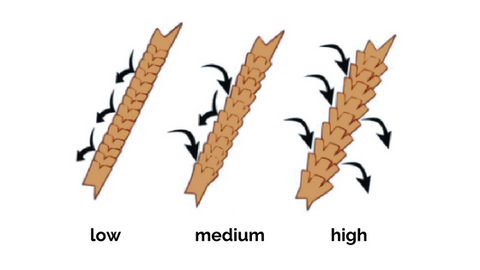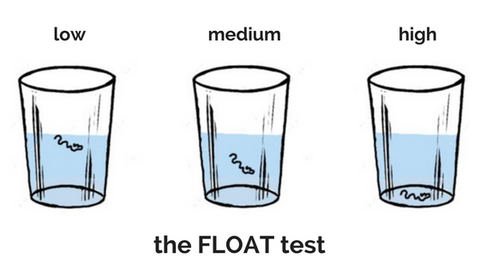
What’s your hair type???

How many times have you wondered what your hair type is? Let’s be honest, we’ve all obsessed at least a little bit about our hair type or curl pattern. Maybe it’s somewhere in-between 3c and 4a, or maybe you have 4a, 4b, AND 4c in different parts of your hair! As one of the most visible characteristics of natural hair, it can seem all-important, and many people think knowing their hair type will ultimately determine how to care for their hair.
But contrary to popular belief, it’s not all about hair type. In fact, your hair has other characteristics that are even more important to know in your natural hair journey.
The truth is, people with the same exact curl pattern may have hair that behaves extremely differently. This is often due to another important but less visible characteristic of hair, called porosity. Keep reading about it this guide:
What is hair porosity?
Porosity is a measurement of your hair’s ability to absorb and hold moisture. It indicates how easily moisture can penetrate your hair. Porosity is determined by the structure of your cuticle- the outer layer of your hair. Low porosity hair has a tightly bound cuticle layer, making it difficult for moisture to penetrate (but also difficult for moisture to escape, once it’s in your hair.) On the other hand, high porosity hair has gaps and holes in the cuticle, allowing moisture to easily pass in and out. Porosity is determined by genetics, but can be altered by external factors like heat and chemical processing.

3 porosity tests you can do at home to determine hair porosity
Porosity is very simple to determine: there are three tests you can do right now!

- The Float Test: Take some strands of hair from your brush or comb (note: use clean hair! Hair products can alter your results), and drop them in a bowl of water. Let them sit for a few minutes. If your hair floats after the time is up, you have low porosity. If it sinks, you have high porosity. (It may float somewhere in the middle of the bowl if you have medium porosity.)
- The Slip ‘n Slide Test: Take a strand of hair and slide your fingers up it, toward your scalp. If you feel small bumps along the way, you have high porosity. If the shaft is smooth, your cuticle is bound tight and you have low porosity hair.
- The Spray Bottle Test: Take a small section of your hair and mist it with a spray bottle. Watch closely: if the water beads up on your hair, it is low porosity. If it absorbs quickly, your hair is high porosity. If you notice the water sitting on your hair for a couple minutes before absorbing in, you have medium porosity hair.
Take a couple minutes now and determine your hair porosity. Then, read on to find out how to take care of your hair!
How to care for low vs. medium vs. high porosity hair
Here are tips on how to care for your hair based on its unique porosity.
How to care for low porosity hair
Low Porosity Hair is moisture resistant- this means that it may be hard to get moisture into your hair, but once you do, you don’t need to worry as much about your hair drying out. All this means is that you have a tightly bound hair cuticle. Your curls can also be prone to product buildup, especially from protein-rich products. Take these steps to take care of your low porosity hair:
- Use a protein-free daily conditioner with humectants (products that attract moisture) like honey or glycerin.
- Use moisture-rich products such as jojoba oil, Shea butter, coconut oil, or mineral oil.
- Use lighter or liquid-based products that will help avoid product build up.
- Try NaturAll's Acai & Flaxseed Fresh Frozé Deep Conditioner, which is rich in moisture to penetrate your low porosity hair, but also is less concentrated with oils, which will help you avoid product buildup.

How to care for medium porosity hair
Medium Porosity Hair has a looser cuticle layer, allowing for a steady but moderate flow of moisture in and out of your hair. Medium porosity stands up well to styling, coloring, and chemicals- which means you should be careful! Frequent treatment can slowly increase the porosity of your hair, making it more difficult over time to maintain such styles and treatments. Follow these instructions to care for medium porosity hair:
- Avoid protein in your daily regimen.
- Deep condition periodically with a product that does include protein.
- Use any solution of NaturAll's Avocado Fresh Frozé Treatment Deep Conditioners to keep your hair moisturized and nourished. The Original Dry solution is a great place to start!

How to care for high porosity hair
High Porosity Hair has gaps and holes in the cuticle layer, which allow moisture to pass quickly in and out. This can lead to frizz and tangling in humid weather, and extreme dryness in dry weather. You’ll need to be careful with activities like swimming or bathing that involve a lot of moisture getting into your hair, since this can cause breakage. Follow these steps to take care of your high porosity hair.
- Use anti-humectants, especially when it’s humid, to seal your cuticles and prevent them from absorbing too much moisture. (Ex: raw shea butter, coconut oil, extra virgin olive oil, palm oil)
- Leave-in conditioners and moisturizers will provide your hair with moisture through the day, but use a sealer such as Avocado Oil to retain moisture and prevent dryness.
- Try the Restoring Fresh Frozé Deep Conditioner from NaturAll, which is highly concentrated with the moisture your hair needs, but also contains Irish Sea Moss and beneficial natural oils that will fortify your strands, making them resistant to breakage.

Common questions about hair porosity
What is the best porosity? Is high vs low porosity good or bad?
There are no "good" or "bad" hair types- it's all about knowing how to care for the hair that you have. Your hair porosity is not a value judgment on your hair. But it's important to take the appropriate steps to care for the beautiful natural hair that you have.
Can porosity change over time? Can I change my hair porosity?
Usually, hair porosity is genetically determined and does not change over time. And in most situations, you will not be able to change your porosity. However, it is possible to increase your hair's porosity with chemical and heat damage. Over time, this damage can permanently leave holes in your hair cuticle, which will result in higher porosity hair.
But, just because you have naturally high porosity hair, does not mean your hair is damaged!
We hope this guide to hair porosity was helpful! Remember, there is one product you should use regardless of hair porosity: deep conditioners. A deep conditioning treatment is important for all curly hair types, since it provides nutrients that all hair needs to grow and remain strong. Check out NaturAll's all-natural Avocado Deep Conditioners.













